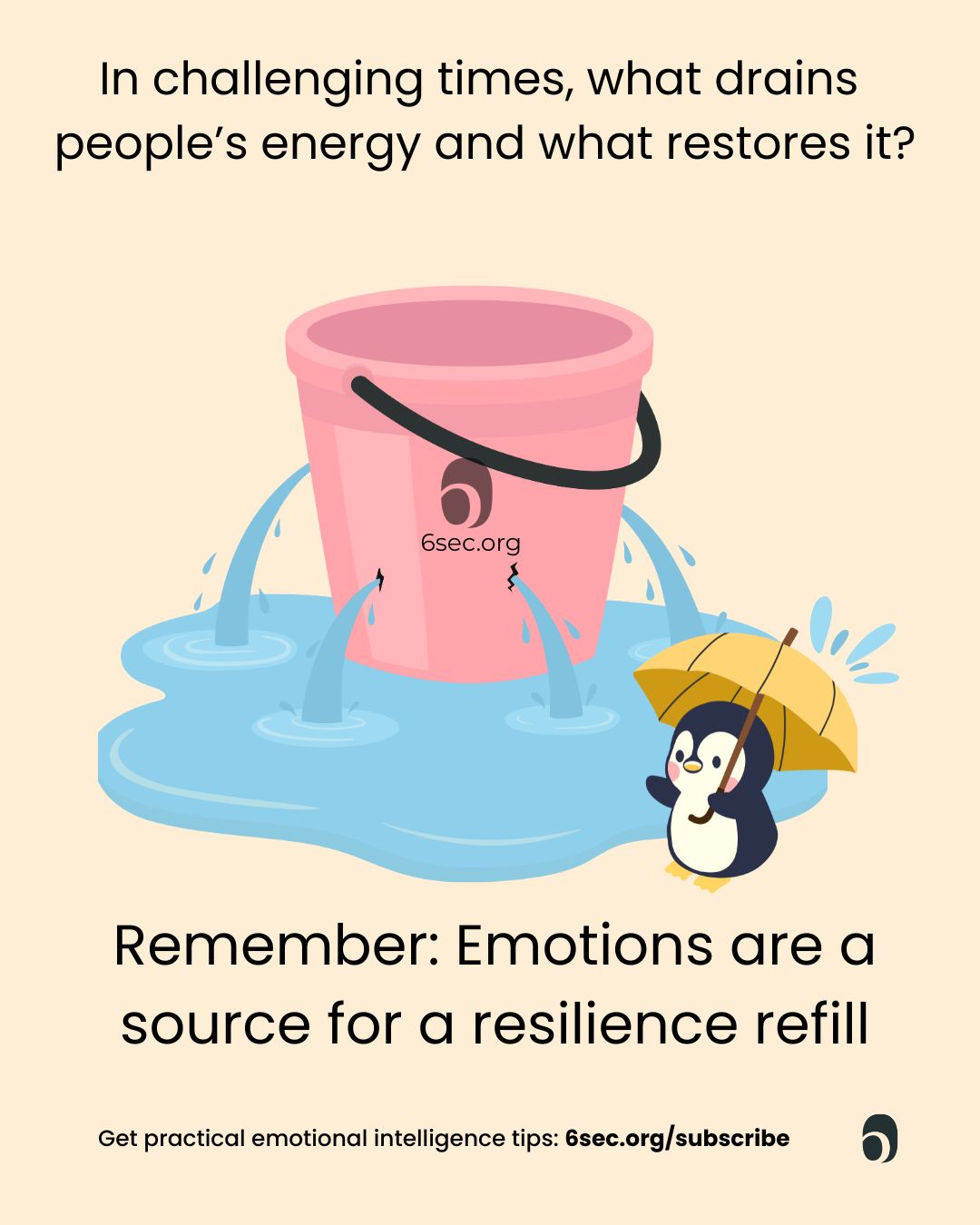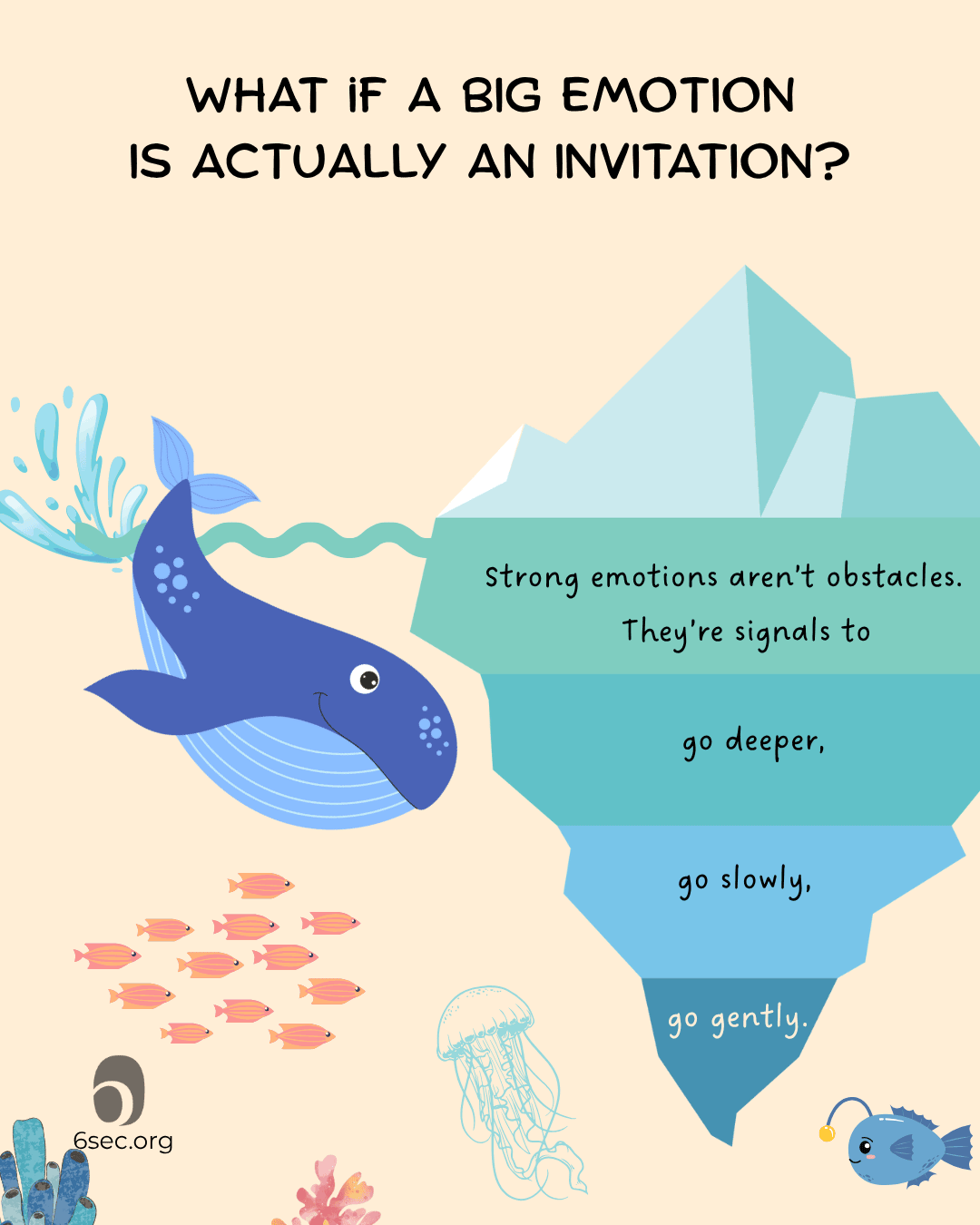Resilience in Recessionary Times: Emotional Intelligence Strategies to Stay Grounded in Escalating Challenge
This is the territory of the emotional recession—a state in which rising stress, collective anxiety, and emotional exhaustion create a backdrop of high friction and low resilience. For more on this concept and its research basis, see Six Seconds’ State of the Heart research hub.
In the emotional recession, people are more agitated, more dysregulated than 5 years ago. That makes almost everything harder: Communication. Collaboration. Socializing. Planning. Closing a deal. Just getting through the day. There’s a hidden tax on every human interaction – and that drains us even more. So, when “our emotional buckets are running low,” we need to both stop the leaks AND refill our buckets. Here’s how.
In the emotional recession, every interaction carries a hidden emotional tax—more weight, more complexity, more burnout. That means emotional intelligence is even more valuable.

Noticing the Leaks: Awareness as the First Move
Before we can “stop the leaks,” we need to notice them. In itself, that’s harder to do in the emotional recession because people all around us are also drained. We might see our own struggles as “not as bad as others are facing,” or we might just become inured to the pain. It’s not obvious to stop and ask: “Should this really be treated as normal?”
The drains on resilience often begin subtly. Some are micro–leaks, nearly invisible; others are macro–drains that push us to the brink. Recognizing them is the first act of regaining agency.
Micro-leaks are subtle drains that sap us over time, such as:
- Notification noise: constant pings, alerts, or internal checking
- Invisible tension: tension in jaw, neck, shallow breathing
- Cognitive clutter: too many open “mental tabs” of incomplete or dangling projects (like tabs on web browser)
- Unresolved relationships: conversations we’re not finishing, hurts we’re not healing
- Micro-interruptions: frequent context switching or distractions
Macro-drains are major drains of our emotional resources; often they’re triggered by big changes or events.
- Yes Patterns: Constantly people-pleasing or overcommitting
- Meaning erosion: losing sight of mission or “why”
- Sleep sacrifice: chronic exhaustion
- Major life stressors: layoffs, health crises, caregiving burdens
- Spin cycle: Persistent worry, rumination, or anxiety (often from trauma or distruption)
Physiological Impact of Leaks
These “leaks” aren’t just imaginary — they exact a physiological toll. Chronic stress and repeated micro-arousals contribute to allostatic load, a multi-system strain on the body’s regulatory systems. Over time, elevated allostatic load is linked to immune suppression, metabolic dysregulation, cardiovascular strain, and cognitive decline. See:
- McEwen, B. (2000). Allostatic load biomarkers of chronic stress and impact on health and cognition. Neurobiology of Aging, 23(1), 17–24.
- Slavich, G.M. (2020). The Immunology of Stress and the Impact of Inflammation on the Brain and Behavior. American Journal of Psychiatry, 177(5), 373–374.
These, and many other studies, point to a destructive spiral: We’re drained, so we have less healthy coping mechanisms. That drains us further, making us even more susceptible to the perils of the emotional recession.
It’s not “just in your head.” Living in uncertainty and trying to cope from a depleted state changes our bodies as well as our brains. For example, prolonged or repetitive worry (known as perseverative cognition) activates sustained autonomic arousal — even in the absence of external threats. Evidence shows links to higher blood pressure, elevated heart rate, increased cortisol, and reduced heart rate variability (HRV). See:
- Ottaviani, C. et al. (2016). Physiological concomitants of perseverative cognition: A systematic review and meta-analysis. Psychological Bulletin, 142(3), 231–259.
- Brosschot, J.F. et al. (2018). Brain-heart interaction in perseverative cognition. Psychophysiology, 55(6), e13094.
Like most problems, this threat is also an opportunity; at some point, your body WILL demand that you change. Hopefully, you decide to do that proactively.
Plugging the Holes: Resetting Yourself for Resilience
Once leaks are named, we can begin to experiment with new, more resourceful responses. That’s where the Window of Tolerance becomes a guiding metaphor.
Dr. Dan Siegel coined the Window of Tolerance to describe the zone in which we can manage emotional intensity and stress while remaining present, accessible, and capable of healthy functioning. Outside that zone, we may slip into:
- Hyperarousal: anxiety, agitation, overwhelm, reactivity
- Hypoarousal: shutdown, numbness, disconnection, freeze
In times of sustained pressure, that window narrows. But resilience grows when we learn to expand the window through intentional practice and also to “shut it on purpose” when we need protection — creating conscious boundaries rather than reactive withdrawal.
The not-very-secret solution to resilience is a mix of self-care and shared-care. Taking care of ourselves is essential – but not enough; real resilience is a team sport.
It’s also important to remember we’re social creatures. As Daniel Siegel observed:
“From early infancy, it appears that our ability to regulate emotional states depends upon the experience of feeling that a significant person in our life is simultaneously experiencing a similar state of mind.”
— Daniel J. Siegel, The Developing Mind
This underscores how regulation is relational—and how much vulnerability we carry when we are deprived of co-regulation in high-stress times.
Workplace Implications: leading resilient systems
What we do as individuals is important; the part you play in a system is also important. As a leader you are uniquely positioned to leverage the systemic benefits – for yourself and other. To win during an emotional recession, build a web of resilience that adds up to greater than the sum of the individuals.
To do so, leadership rooted in tasks and toughness breaks down. What sustains us is emotional intelligence: the capacity to notice the emotional clues, choose fresh patterns, widen our regulatory capacity, and refill ourselves – and others – via connection and purpose.
The essential pillar is a shift in definition from leading tasks or functions —> to leading people. As a people-leader, your focus changes and you seek out opportunities to connect and lift one another up. As you’ll see below, this centering leadership on people and purpose “automatically” engages many of the most powerful mechanisms for resilience.
Resilient leadership isn’t about toughness, it’s about staying emotionally agile, building support, and anchoring decisions in long-range purpose.
Refilling Your Tank: Building the Resources for Flourishing
Once the leaks are slowed, resilience requires filling back up. Research-backed EQ practices include:
- Emotional labeling (naming feelings before reacting)
- Values-anchoring (reconnecting with deeper purpose)
- Empathy & self-empathy (compassion inward and outward)
- Micro-rituals of renewal (small resets like breath or reflection or connect with nature)
- Navigate Emotions (tune into the wisdom of your feelings, and work with them. Engage supportive feelings such as awe and gratitude to help you shift)
We regularly share practical ideas on our 6secondseq Instagram and on my LinkedIn, please join the discussions.
When we grow and practice emotional intelligence, something changes inside us that ripples outward into systems and society.
Emotions as Whispers of Wisdom: You Already Carry the Map
Strong emotions are not obstacles to overcome. They are invitations—data that point to unmet needs or deeper values. Anger signals a boundary. Sadness points to something precious that needs tending. Even guilt or shame can remind us of what matters.
In the emotional recession, it can be harder to hear these whispers beneath the noise of depletion. That makes practicing emotional intelligence all the more powerful—and necessary.
As I share in Emotion Rules (Mar, 2026), big emotions are both challenges and invitations. The most difficult emotions are often the most powerful teachers. The first step is practicing to strengthen our ability to hear our own emotions. Not just the surface ones, but the quiet emotions that offer us nuance and perspective.
Emotions are internal signals – they’re part of how we regulate ourselves and prepare to manage threats and opportunities. As social creatures, emotions are also shared. They’re part of how we continuously, and almost instantaneously connect with others.
To Supercharge resilience: go beyond yourself
There’s growing evidence from randomized trials and meta-analyses that connection-based practices work for replenishing well-being. For example:
This post is the first teaser of my new book, Emotion Rules
- A meta-analysis of gratitude interventions across 25 RCTs (N = 6,745) found that expressing gratitude significantly improves psychological well-being (Kirca, Malouff, & Meynadier, 2023).
- A systematic review and meta-analysis of 27 studies of acts of kindness showed that helping others yields a small-to-medium boost in the helper’s well-being (Curry et al., 2018).
- A broader meta-analysis of prosociality reported a reliable association with well-being across 201 effect sizes (N≈198,000), with stronger links for eudaimonic (purpose-oriented) outcomes and informal helping (Hui et al., 2020).
- Gratitude shows moderate-to-strong correlations with happiness and life satisfaction (Portocarrero et al., 2020).
- Recent meta-analytic evidence indicates a positive association between feeling awe and prosocial behavior (Li et al., 2024).
- A landmark meta-analysis found that stronger social relationships predict substantially better survival—underscoring the health value of connection (Holt-Lunstad, Smith, & Layton, 2010).
In the Six Seconds process for practicing emotional intelligence, we engage this power through a step we call Give Yourself. When give your energy, commitment, and emotional strength to others and a worthy purpose, you get back tremendous returns. This pursuit is driven by two emotional intelligence competencies:
- Increase Empathy (as mentioned above, this works best when it’s mutual — not “empathizing” as a one-way street).
- Pursue Noble Goals (putting your purpose into action by integrating it into your daily way of being).
In short: The most powerful methods for renewal are rooted in this truth: We are social beings. So to fully fuel yourself, step into connection, service, gratitude… lift other up… look for small and big ways to contribute.
May Your Bucket Overflow: A vision of shared thriving
Resilience in recessionary times is not about ignoring hardship. It’s about developing the internal agility to notice leaks, plug them intentionally, modulate our regulatory window, and refill through connection and purpose. Emotions are not adversaries—they are wisdom. In hearing them well, we reclaim choice, agency, and stability—not only for ourselves, but for those we lead and serve.
Learning from nature, we can see that the most resilient organisms are an integral part of resilient systems. Is the network of roots that create a hardy forest grove: The trees literally share and sustain one another. Likewise, examining research on the most effective ways to “fill our buckets,” we thrive by sharing and sustaining one another.
For more on how to use emotional intelligence to handle challenges, I recommend:
Anticipation + Joy
Transforming Stress
Free goal setting journal
- Grappling with Challenging Emotions as a Manager: 18 Effective Emotional Intelligence Strategies - November 3, 2025
- What Are Emotions? Understanding the Science and Meaning Behind How We Feel - October 25, 2025
- Resilience in Recessionary Times: Emotional Intelligence Strategies to Stay Grounded in Escalating Challenge - October 5, 2025




